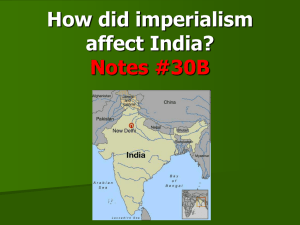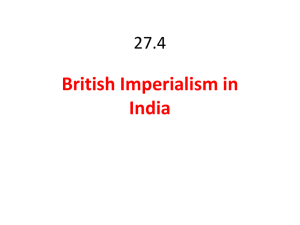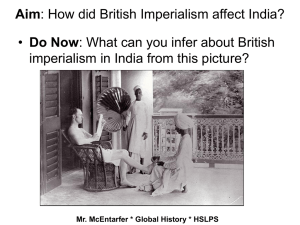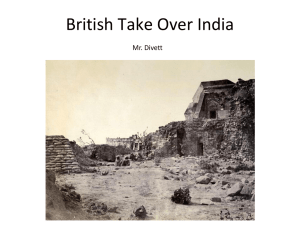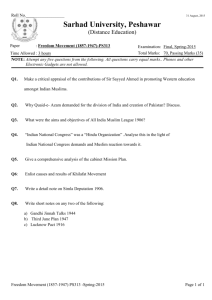Cause & Effect: British Rule in India
advertisement
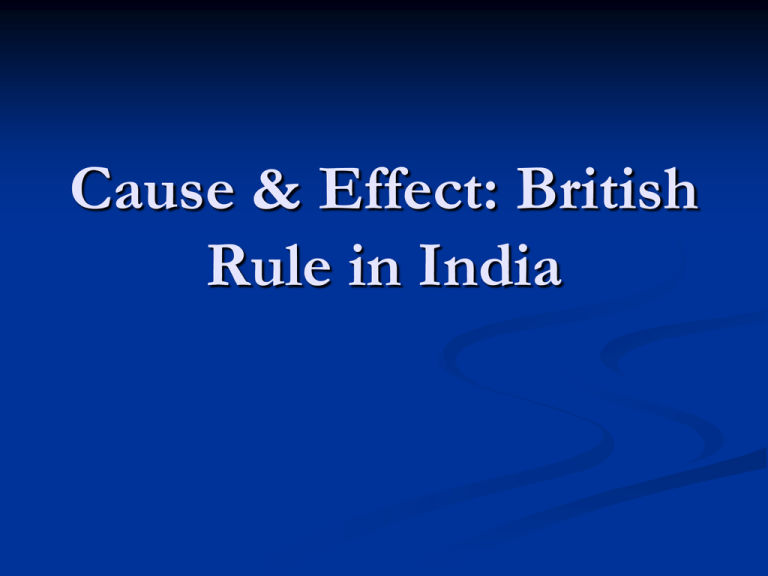
Cause & Effect: British Rule in India Rise of the British East India Company Causes land and trade lack of Indian unity/rival kingdoms/conflict long decline of Mughal Empire Seven Years War (1756 – 1763) British/French Rivalry Treaty of Paris 1763: Britain rights in India Robert Clive: BEIC Rise of the British East India Company Effects competition between British and French for control of India – defeat of French in Bengal wealth from India right to collect taxes from Mughal Empire protect BEIC with laws and courts control more land – direct/indirect rule Sepoy Rebellion (1857) Causes sepoy: Indian troop who served in British Army 1st wide spread Indian rebellion grievances against British rule interfered with social and religious customs Examples High taxes on farmers Resentment of Christian missionaries Lose caste if traveled overseas Muslim and Hindus together cartridge grease Mangal Pandey (19 July 1827 – 8 April 1857) Indian soldier who played a key part in events immediately preceding the outbreak of the Sepoy contemporary British opinion considered him a traitor and mutineer Pandey is widely regarded as a freedom fighter in modern India. 1984, the Indian government issued a postage stamp to commemorate him. Sepoy Rebellion Effects India becomes a British colony/direct rule (1858) Act for Better Government For India increased distrust between Indians and British official start of British Raj (British rule in India) British Improved Indian Infrastructure Causes the British wanted to increase trade and control their colony Sepoy Rebellion British Improved Indian Infrastructure Effects improved/built roads, railroads, modernized ports, telegraphs, schools, health care improved response to uprisings/disasters increased trade better control of colony by British India more connected New Economic Patterns Causes British Raj Industrial Revolution Need for raw materials and foreign markets Discouraged local Indian industries and limited Indian imports to Britain New Economic Patterns Effects (Listing Question) Destroyed Indian traditional economy Locally made goods disappeared Indians bought expensive British made products: imports Cash crop economy Less food crops India dependent on Great Britain Social Changes Causes British Raj: imposed British way of life better health care/improved sanitary conditions need for jobs schools/colleges for higher castes ethnocentrism of British education Outlawed certain customs Social Changes Effects (Listing Question) population growth Urbanization Loss of traditional ways of life British educated Indian middle class make like British (p.197) English a common language learned about liberty, freedom, democracy resentment to British rule = rise of Indian nationalism Formation of the INC (1885) Causes Indian Educated elite = learning about liberty, freedom, democracy wanted to return to Hindu traditions = Hindu nationalism wanted political reform Formation of the INC (1885) Effects gradual political change/more gov’t jobs to Indians 1920: Gandhi: wanted home rule Formation of the Muslim League (1906) Causes Hindu Nationalism/Formation of INC respect for Muslim Culture/past conflicts protection of Muslim rights Muhammad Ali Jinnah Formation of the Muslim League (1906) Effects Increased tension between Hindus and Muslims Push to divide India into 2 nations based on religion Closure With a partner or independently evaluate whether the economic and social changes were positive (+) or negative (-) on India. 1. 2. Place a “+” for positive or a “-” next to each effect under “New Economic Patterns” and “Social Changes” On the back of the Chart: Were the effects of the British Raj on India mostly positive or negative? Support your answer with several pieces of evidence.


